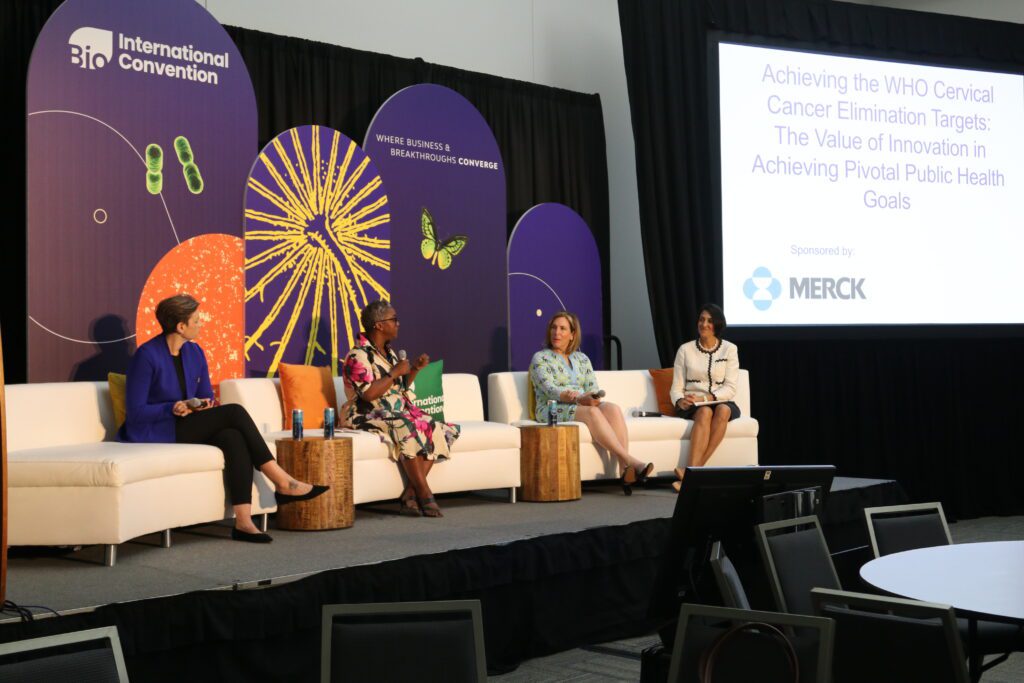In August 2020, the World Health Organization (WHO) adopted a global strategy to eliminate cervical cancer in our lifetime.
“To eliminate cervical cancer,” according to the WHO, “all countries must reach and maintain an incidence rate of below 4 per 100,000 women.”
To reach this goal, the WHO set three targets:
- Vaccination: 90% of girls fully vaccinated with the HPV vaccine by the age of 15.
- Screening: 70% of women screened using a high-performance test by the age of 35, and again by the age of 45.
- Treatment: 90% of women with pre-cancer treated and 90% of women with invasive cancer managed.
The deadline to reach these goals is 2030, which is a north star for many in women’s health and oncology.
“I don’t necessarily know that I thought eliminating cervical cancer was something that was going to happen in my lifetime,” said Citseko Staples Miller, Managing Director of Healthcare and Life Science at FTI Consulting. She spoke at the Biotechnology Innovation Organization (BIO) 2024 International Convention during a panel, “Achieving the WHO Cervical Cancer Elimination Targets: The Value of Innovation in Achieving Pivotal Public Health Goals.”
“The fact that we are here and that we have a bit of a roadmap with some great mile markers along the way to help us to understand where we need to go to measure progress is just tremendously exciting,” she said.
How far we’ve come on cervical cancer
Indeed, there are a number of success stories in the realm of cervical cancer elimination. BIO Ventures for Global Health and Merck, among other organizations, have worked to address cervical cancer in Rwanda.
“In Rwanda, we have had programs where we have had robust activation,” explained Jenelle Krishnamoorthy, Ph.D., Vice President and Head of Global Public Policy and International Affairs at Merck. “We have 98% of the eligible individuals vaccinated. And that was a huge multi-sectoral program where we brought stakeholders together so that they could talk about the leadership that it takes, and that this is the right thing to do for your kids.”
The work being done in Europe has also been heartening. “In France,” Krishnamoorthy continued, “we were able to look at this in a holistic way. We asked, How can we reach people and kids easier?” In addition to reaching out through schools and pharmacies, legislation was passed to enable screenings and vaccinations. The legislation funded further outreach via faith-based groups and parent-teacher groups, among others.
In the U.S., initiatives include Alabama’s Breast & Cervical Cancer Program, which provides free breast and cervical cancer screenings for women who meet eligibility guidelines, as well as utilizing community partners to make sure that they can reach people.
Similarly, the success of programs in Scotland has excited those working to address cervical cancer. As Bio.News reported in January, in Scotland, “cervical cancer in women born between 1988–1996 who were fully vaccinated against HPV between the ages of 12 and 13.”
And with the increase in self-sampling kits to screen for cervical cancer, there is the opportunity to reach previously unreachable communities. “It doesn’t sound like the most exciting technology, it’s not the coolest science, but it’s so important to be able to reach the women who need it,” said Joanna Sickler, MBA, MPH and Vice President at Roche Diagnostics. “And we’re just really thrilled about what this is going to mean for the programs that we work in around the world.”
Can we reach the 2030 goals?
Even accounting for all of the progress, there is still much more work to do to hit the WHO’s 2030 goals on cervical cancer.
“Unfortunately, the reality is the cervical cancer elimination targets are not going as well as they could be,” said Sickler. “We still have a lot of women that need to be reached, and I really think that everyone, both public and private sector, need to take accountability for what we ourselves can do better at and how we can listen and work with the other side because we’re not going to get this done if we don’t all work together.”
Dr. Krishnamoorthy challenged the audience to identify just one friend “who talks to everyone,” and tell them about vaccination and the prevention of cervical cancer. “That’s all I’m asking you to do.”




